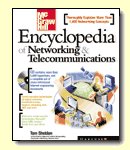|
Site home page
(news and notices)
Get alerts when Linktionary
is updated
Book updates and addendums

Get info about the Encyclopedia of Networking
and Telecommunicatons, 3rd edition (2001)

Download the electronic version of the Encyclopedia
of Networking, 2nd edition (1996). It's free!
Contribute to this site
Electronic licensing info
|
|
Collaborative Computing
Related Entries Web Links New/Updated Information
Note: Many topics at this site are reduced versions of the text in "The Encyclopedia of Networking and Telecommunications." Search results will not be as extensive as a search of the book's CD-ROM.
Collaborative computing allows users to work together on documents and projects, usually in real time, by taking advantage of underlying network communication systems. Whole new categories of software have been developed for collaborative computing, and many existing applications now include features that let people work together over networks. Here are some examples:
- Application suites such as Microsoft Office and Exchange, Lotus Notes, and Novell Groupwise that provide messaging, scheduling, document coauthoring, rules-based message management, workflow routing, and discussion groups.
- Videoconferencing applications that allow users to collaborate over local networks, private WANs (wide area networks), or over the Internet. See "Videoconferencing" for more information.
- Internet collaboration tools that provide virtual meetings, group discussions, chat rooms, whiteboards, document exchange, workflow routing, and many other features. Multicasting is an enabling technology for groupware and collaborative work on the Internet that reduces bandwidth requirements. A single packet can be addressed to a group rather than having to send a packet to each member of the group. See "Multicasting" for more details.
- Instant messaging is like electronic mail that happens in real time. When you log onto a company server or an Internet site that tracks your "presence," other people whom you designate are notified that you are online and available for instant messaging. They can send you a message that appears immediately on your screen. You can send an immediate reply. Instant message has huge potential in many applications. Companies can use it to form ad hoc meetings or organize meetings. It is even being used as a signaling protocol to indicate when a person changes their physical location so that Internet phone calls can be redirected to that location. Refer to "Instant Messaging" for more details.
- Workflow management is about coordinating the flow of documents (invoices, reports, legal documents, etc.) within an organization from one person to another. Refer to "Workflow Management" for more details.
A good example of collaborative applications designed for Internet use are Microsoft's NetShow and NetMeeting. NetShow is a multimedia Web technology that enhances broadcasting with interactive content like audio, illustrated audio (images and sound), and video. This is delivered using multicast technology, which means that multiple users can receive the same broadcast at the same time. NetMeeting is a multimedia conferencing tool that works over the Internet or intranets. It provides what are essentially videophone services between users.
The topic "File Sharing" discusses some interesting services on the Web that support collaborative computing via personal shared file areas and chat rooms.
Copyright (c) 2001 Tom Sheldon and Big Sur Multimedia.
All rights reserved under Pan American and International copyright conventions.

|

